Because the ChatGPT second, on November 30, 2022, it was clear that what we now name AI (LLMs) would have slowly then instantly redefined the entire search engine trade.
Effectively, virtually three years into that journey, we’re getting there. In actual fact, if within the final three years, LLMs have redefined a great chunk of the informational journey for search, and discovery, we’re not coming into one other important part: the redefinition of the transactional journey!That is taking place in parallel for the main gamers within the area: ChatGPT and Google AI Mode.
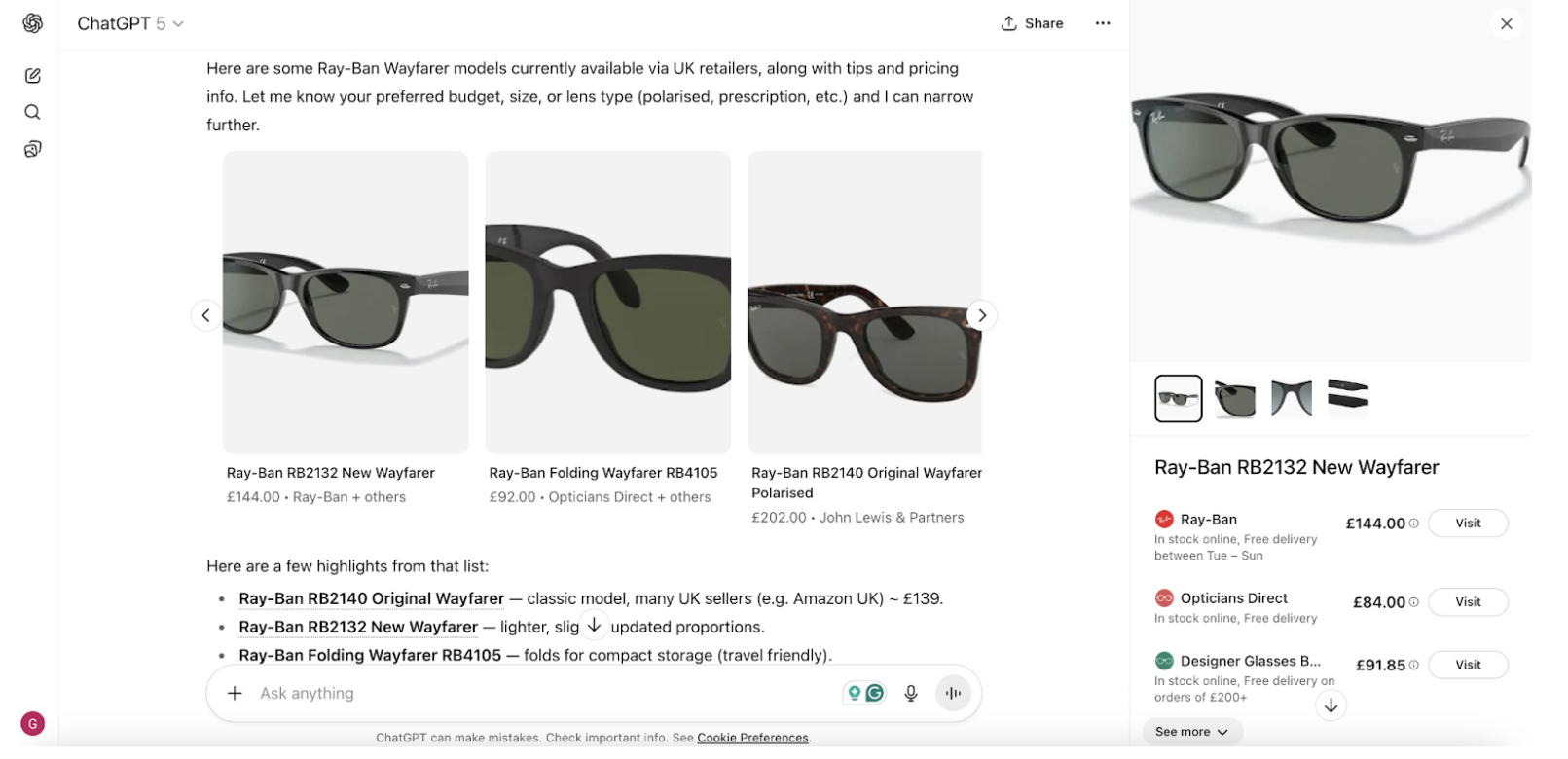
An instance of a immediate inside ChatGPT, which, due to the semantic enrichment, permits Ray-Ban to get visibility throughout AI search, but that is solely the beginning of a journey that’s transferring from discovery to a complete transactional journey the place the agent aligns with the human and completes the acquisition.
On September 29, 2025, OpenAI basically altered the e-commerce panorama. With the launch of Immediate Checkout, 700 million weekly ChatGPT customers can now buy merchandise straight via dialog with out ever leaving the chat interface. The acquisition stream, which as soon as required a number of web page masses, type fills, and choice factors, now happens in just a few faucets inside an AI dialog.
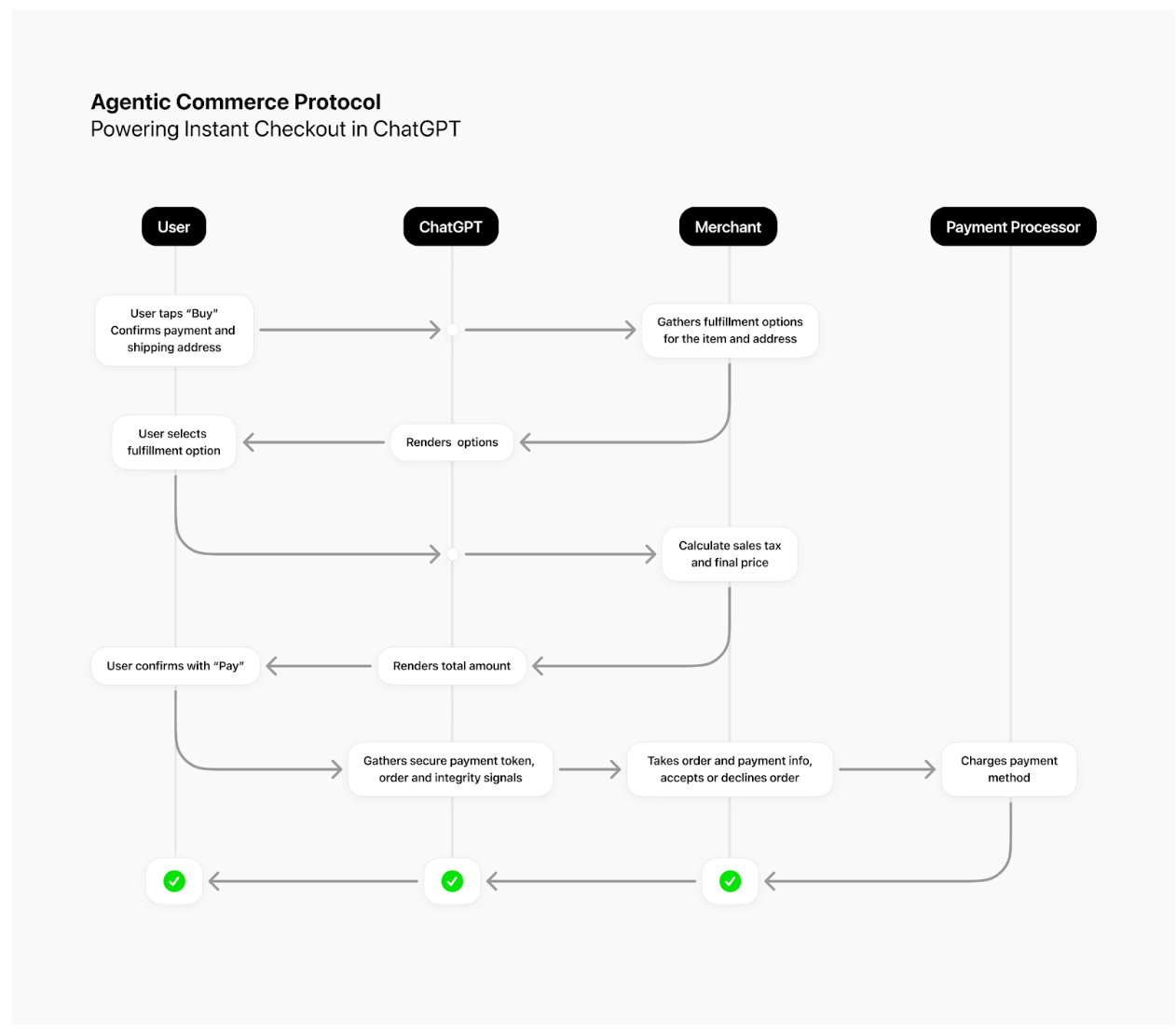

Supply: OpenAI
Beginning with U.S. Etsy sellers and increasing imminently to over one million Shopify retailers—together with main manufacturers like Glossier, SKIMS, Spanx, and Vuori—this marks OpenAI’s definitive pivot from info retrieval to transaction execution. ChatGPT is not simply answering questions on merchandise; it’s finishing purchases, processing funds, and coordinating achievement.
However this isn’t nearly OpenAI. Whereas ChatGPT grabbed headlines, Google has been constructing parallel infrastructure that will show much more complete. Google’s AI Mode has deployed agentic capabilities that may search throughout a number of platforms, monitor costs over time, and mechanically full purchases through Google Pay when user-defined circumstances are met. With entry to greater than 50 billion product listings in its Buying Graph—refreshing 2 billion listings each hour—Google possesses information infrastructure benefits that no competitor can simply replicate.
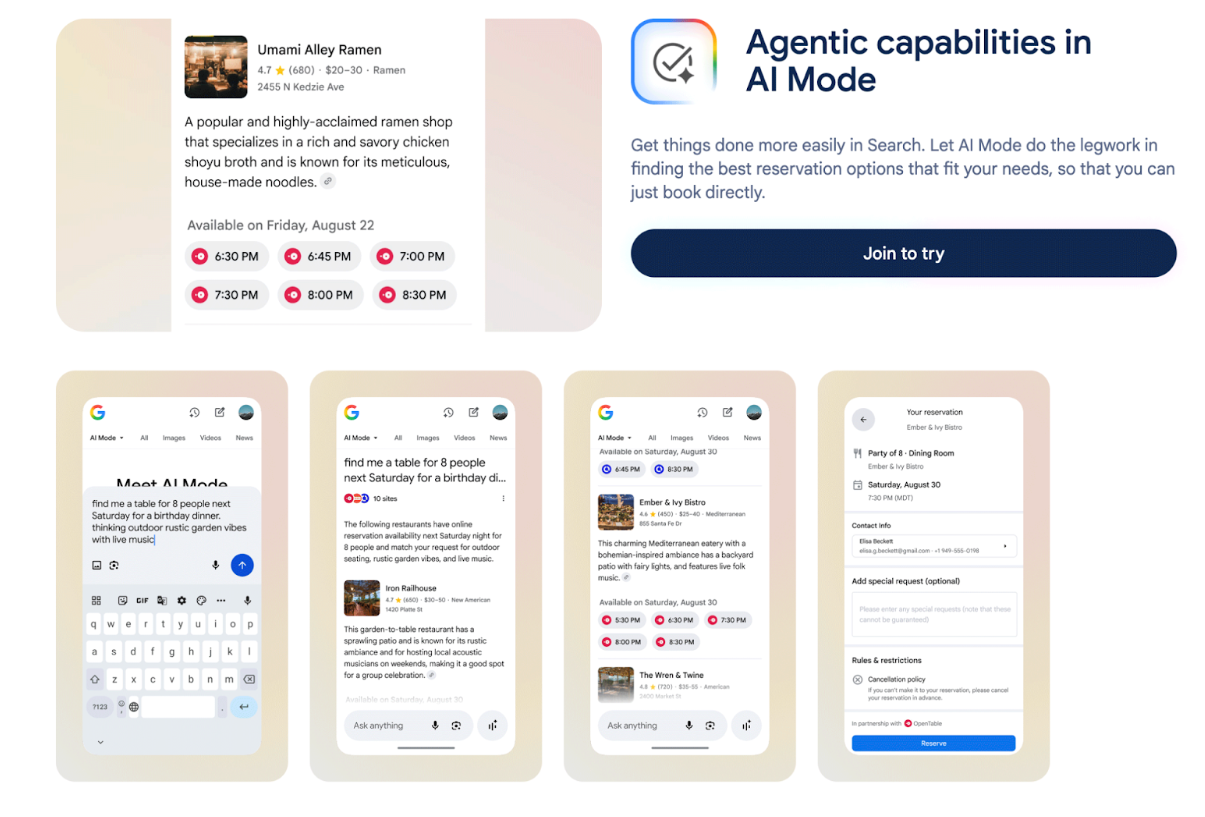

Supply: X
The impression is already measurable. Knowledge from SimilarWeb reveals one thing that ought to alarm conventional e-commerce gamers: ChatGPT-referred site visitors converts at 11.4%, practically double the ten.2% conversion fee of direct visits, and considerably outperforming paid search (9.3%), natural search (5.3%), e mail (4.6%), and social media (3.8%). The year-over-year development from June 2024 to June 2025 reveals a forty five% improve in conversion charges, with notably sharp acceleration from March 2025 onward.
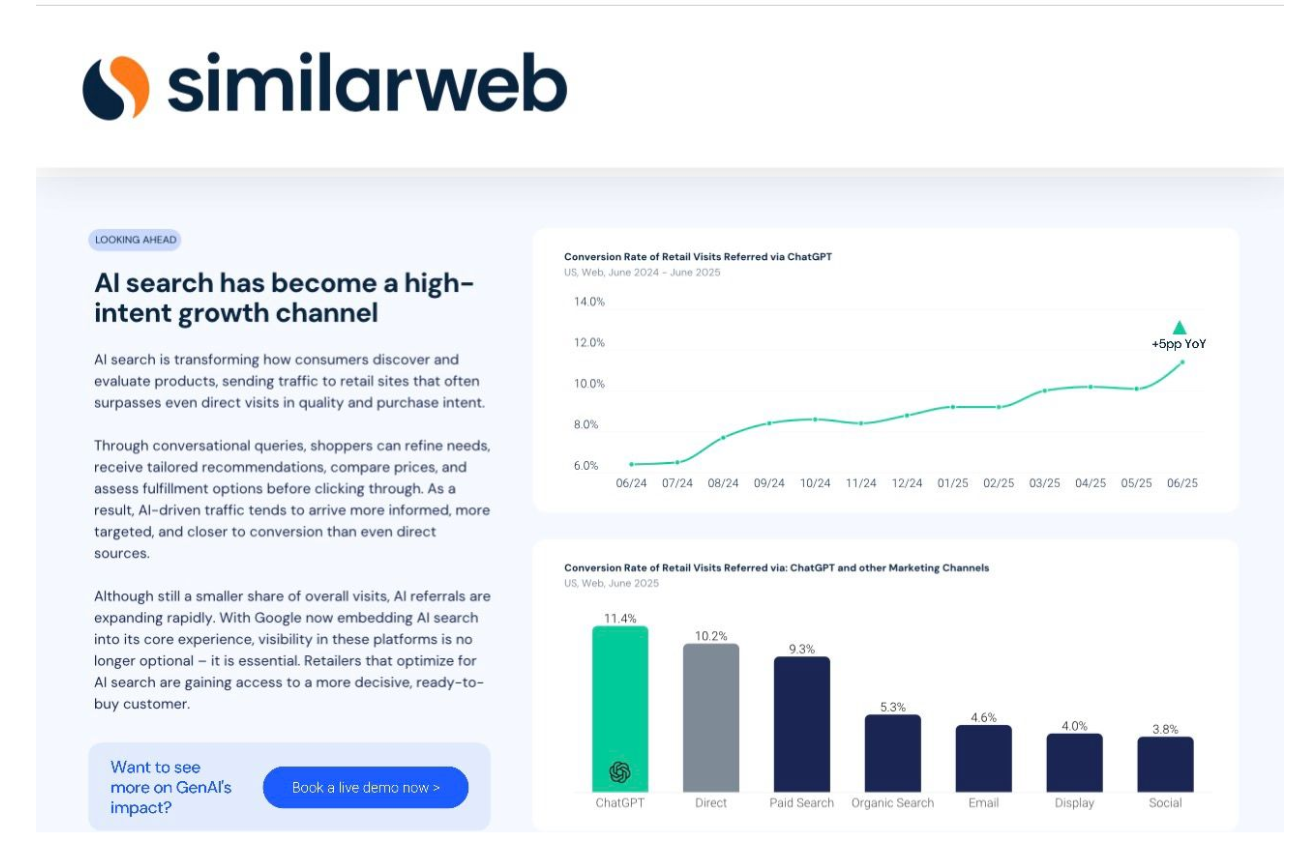

AI search has turn out to be what the trade by no means noticed coming—not simply one other channel, however a high-intent progress channel that outperforms each conventional discovery methodology.
The implications for e-commerce are seismic. The query is not whether or not AI will disrupt commerce, however how briskly and the way fully it’s going to reshape your complete worth chain from discovery to cost. For e-commerce companies—from small retailers to enterprise platforms—the difference window is slim and shutting quickly.
The Convergence: When Three Giants Assault Commerce Concurrently
OpenAI’s Immediate Checkout Technique
The mechanics of ChatGPT’s Immediate Checkout reveal each sophistication and strategic ambition. When a person asks a shopping-related query—”greatest climbing boots underneath $150″ or “birthday reward concepts for a 10-year-old nephew”—ChatGPT surfaces related merchandise from throughout the online. Product outcomes are natural and unsponsored, ranked purely on relevance to the person, in keeping with OpenAI’s announcement. If a product helps Immediate Checkout, customers can faucet “Purchase,” verify order particulars, delivery handle, and cost info, then full the acquisition with out ever leaving the chat.
Behind the scenes, the transaction flows via the Agentic Commerce Protocol, co-developed with Stripe. ChatGPT acts because the person’s AI agent, securely passing info between person and service provider. The service provider handles orders, funds, and achievement utilizing their present techniques—ChatGPT doesn’t course of funds straight however coordinates the transaction. OpenAI takes a small service provider payment on accomplished purchases, establishing a commission-based income mannequin that would show transformative given the platform’s scale.
The market response was speedy: Etsy’s inventory jumped practically 16% on the announcement, with traders recognizing that entry to 700 million weekly customers represents a distribution channel that would rival or exceed conventional engines like google.
The system presently helps single-item purchases, with multi-item carts and expanded regional availability slated for the approaching months. However the technical basis carries implications that stretch far past OpenAI’s speedy implementation.
The Agentic Commerce Protocol is open-source, designed to work throughout platforms, processors, and enterprise fashions. This isn’t a closed ecosystem—it’s an try to ascertain the rails for AI-native commerce. For retailers already processing funds with Stripe, enabling agentic funds requires as little as one line of code. Retailers utilizing different cost processors can nonetheless take part via Stripe’s Shared Cost Token API or by adopting the Delegated Funds Spec with out altering their present infrastructure.
The strategic calculation is obvious: OpenAI goals to ascertain itself as the usual protocol for AI commerce, not simply one other closed platform. If profitable, this may give OpenAI a big benefit over your complete AI-commerce ecosystem, at the same time as rivals develop their very own agent-shopping experiences.
Google’s Twin-Technique Dominance: Enjoying Each Sides of the AI Commerce Revolution
The Two-Pronged Assault
Whereas OpenAI captured media consideration with its Immediate Checkout announcement, Google has quietly deployed what often is the most complete—and strategically refined—AI commerce infrastructure available in the market. The size and multi-layered method reveals long-term strategic planning that predates OpenAI’s announcement by months.
What makes Google’s technique uniquely highly effective is that it’s taking part in either side of the AI commerce transformation concurrently:
Centralization via Google AI Mode/Gemini — constructing a proprietary commerce engine that retains customers inside Google’s ecosystem.
Decentralization via the Brokers-to-Funds (A2P) Protocol — creating open infrastructure that enables any AI agent to finish transactions wherever
This twin technique provides Google optionality that no competitor possesses. If the market consolidates round proprietary platforms, Google wins via AI Mode. If the market fragments throughout a number of AI brokers, Google wins via A2P protocol adoption. Both method, Google captures worth.
The Centralized Play: AI Mode as Commerce Engine
Google’s AI Mode now contains agentic capabilities that basically compress the procuring journey. When a person asks for restaurant suggestions with a number of constraints—social gathering measurement, date, time, location, delicacies preferences—AI Mode searches throughout a number of reservation platforms and web sites, finds real-time availability, and presents a curated checklist of eating places with obtainable slots. The system then hyperlinks on to reserving pages, dealing with the tedious work of evaluating choices throughout fragmented platforms.
The procuring purposes prolong this framework. Customers can ask AI Mode for product suggestions utilizing pure language queries like “cute journey bag for wet climate journeys.” AI Mode runs what Google calls a “question fan-out”—executing a number of simultaneous searches to know what makes a bag appropriate for each wet circumstances and lengthy journeys, then synthesizing outcomes into personalised suggestions with visible product panels that replace dynamically because the dialog continues.
The agentic checkout completes the loop. Customers can monitor product costs by tapping “monitor value” on any itemizing, setting preferences for measurement, shade, and most spend. When circumstances are met, Google’s brokers add gadgets to the cart on the service provider’s website and securely full checkout with Google Pay on the person’s behalf—all with specific person affirmation earlier than remaining buy.
The Unmatched Knowledge Infrastructure Benefit
However Google’s true benefit isn’t any single function. It’s information infrastructure at a scale no competitor can match. Google’s Buying Graph now accommodates greater than 50 billion product listings, with greater than 2 billion listings refreshed each hour. This real-time product catalog, mixed with integration throughout Google Search, Maps, Gmail, and Calendar, creates a personalization engine that improves with each interplay.
AI Mode now delivers outcomes tailor-made to non-public preferences based mostly on earlier conversations, locations looked for or tapped on in Search and Maps. In case you’ve beforehand looked for Italian eating places with out of doors seating, AI Mode infers these preferences and weights suggestions accordingly. The system explicitly asks for person permission earlier than utilizing this context, however the aggressive benefit is obvious: Google isn’t simply facilitating transactions; it’s constructing a desire graph that compounds in worth over time.
The mixing depth poses challenges for rivals. When customers ask “what ought to I do that weekend in Nashville with foodie pals?” AI Mode can reference upcoming journeys in Gmail, restaurant preferences from Maps historical past, and calendar availability to offer deeply contextualized suggestions. This cross-product information integration represents a moat that standalone AI assistants can’t simply replicate.
The Alternative Panorama: Why This Might Be E-commerce’s Largest Development Channel
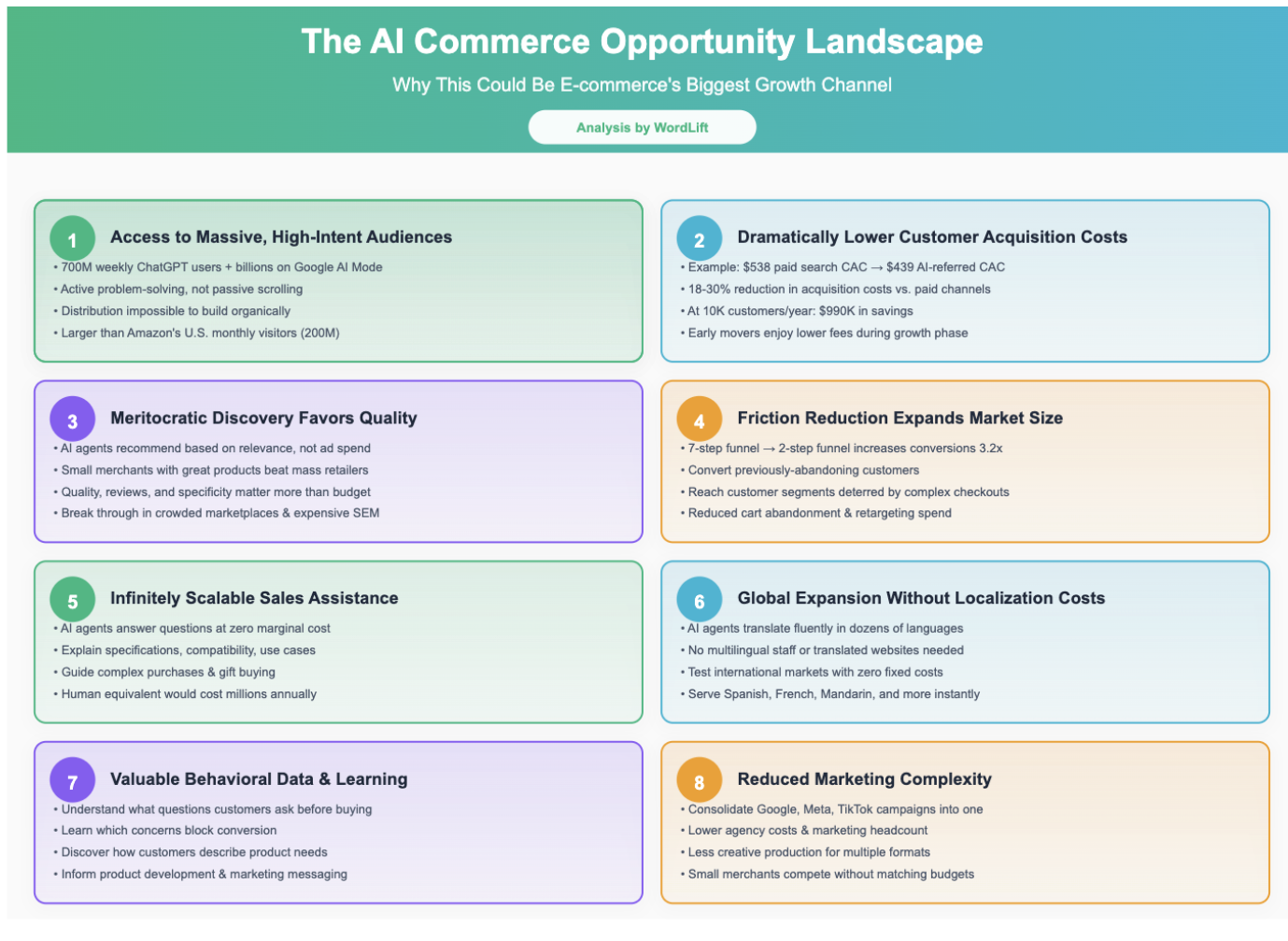

Earlier than inspecting the challenges, let’s make clear the chance scale. This isn’t about defending present market share—it’s about accessing fully new buyer acquisition channels with superior economics.
1. Entry to Large, Extremely-Engaged Audiences
700 million weekly lively ChatGPT customers represents an viewers bigger than:
Amazon’s month-to-month U.S. guests (~200 million)
Instagram Buying’s lively person base (~500 million)
Pinterest’s month-to-month lively customers (~450 million)
And these customers are participating deeply. In fact, ChatGPT doesn’t but have the intensive stock of merchandise that Google and Amazon have; but, the OpenAI chatbot (which is evolving into an agent) is aware of every part about you, and within the quick time period, it would make the most of reminiscence to do what stock can’t. As well as, ChatGPT will leverage deep integrations with gamers like Shopify and Etsy to start out gaining traction on the stock aspect.
ChatGPT already processed over 1 billion internet searches in a single week, with “an enormous portion” of queries associated to procuring and commerce, in keeping with OpenAI. This isn’t passive scrolling—it’s lively problem-solving, the place buy intent is explicitly said.
Google’s AI Mode provides much more scale, with integration straight into Search reaching billions of customers globally. For retailers, this represents distribution entry that might be inconceivable to construct organically.
2. Dramatically Decrease Buyer Acquisition Prices
The conversion fee benefit interprets on to CAC (Buyer Acquisition Value) enchancment, for now.
The early-mover benefit is much more pronounced. Channel prices usually improve as competitors intensifies. Retailers who set up presence in AI commerce now will get pleasure from:
Decrease transaction charges throughout the progress part.
Algorithm benefits as platforms be taught which retailers present good experiences.
Model recognition as innovation leaders.
Knowledge benefits from understanding buyer conduct in AI contexts.
3. New Product Discovery Mechanisms That Favor High quality
Conventional search and social commerce favor manufacturers with massive advertising budgets. AI brokers, in contrast, make suggestions based mostly on relevance to person wants—creating alternatives for smaller retailers with differentiated merchandise.
A ceramics artist on Etsy competing with mass-market retailers in Google Buying faces extreme disadvantages. However when a ChatGPT person asks “distinctive handmade items for a pottery fanatic,” the AI agent evaluates high quality, uniqueness, and relevance—components the place small retailers can win.
This creates a extra meritocratic discovery setting the place product high quality, critiques, and specificity matter greater than promoting spend. Retailers who’ve struggled to achieve visibility in crowded marketplaces or costly paid search auctions can obtain breakthrough distribution via AI brokers.
4. Friction Discount Will increase Market Measurement
The funnel collapse from seven steps to 2 doesn’t simply enhance conversion—it expands the addressable market. Many potential clients abandon purchases on account of checkout friction, not lack of curiosity. By eradicating limitations, AI brokers convert previously-lost clients.
Analysis constantly reveals that every extra step in a purchase order funnel causes 10-20% dropoff. A seven-step funnel would possibly convert 100 preliminary guests into 20 purchases. A two-step funnel converts 100 guests into 64 purchases—a 3.2x enchancment from friction discount alone.
For retailers, this implies:
Larger conversion charges on present site visitors.
Skill to transform previously-abandoning clients.
Growth into buyer segments deterred by complicated checkouts.
Decreased cart abandonment prices and retargeting spend.
5. Dialog as Conversion Device
AI brokers don’t simply full transactions—they act as infinitely scalable gross sales assistants who can reply questions, handle considerations, evaluate choices, and information buy selections. That is notably priceless for:
Complicated merchandise: Explaining technical specs, compatibility, or use instances .
Thought of purchases: Addressing considerations about sizing, high quality, or suitability.
Reward shopping for: Serving to customers navigate unfamiliar product classes.
Analysis-intensive classes: Synthesizing critiques, evaluating choices, explaining variations.
A human customer support workforce able to dealing with this at scale would value hundreds of thousands yearly. AI brokers present this session layer at zero marginal value, bettering buyer expertise whereas growing conversion.
6. World Growth With out Localization Prices
AI brokers talk fluently in dozens of languages, mechanically translating product info, answering questions, and facilitating purchases throughout linguistic limitations.
A U.S. service provider beforehand restricted to English-speaking markets can instantly serve:
Spanish-speaking clients in Latin America.
French-speaking clients in Europe and Africa.
Mandarin-speaking clients in China and Southeast Asia.
Dozens of different linguistic markets.
This occurs with out hiring multilingual workers, translating web sites, or constructing regional operations. The AI agent handles localization mechanically, dramatically decreasing worldwide enlargement prices.
7. Knowledge and Studying Benefits
Early adopters acquire entry to behavioral information about how clients work together with AI brokers:
What questions they ask earlier than buying.
Which considerations block conversion.
How they describe product wants.
What comparability components matter most.
This information is invaluable for:
Product improvement knowledgeable by precise buyer language.
Advertising and marketing messaging that addresses actual considerations.
Aggressive positioning based mostly on what clients truly evaluate.
Content material technique optimized for AI agent understanding.
Retailers who wait will enter the channel with out these insights, at a big drawback.
8. Decreased Advertising and marketing Complexity
Present e-commerce advertising requires managing:
Google Adverts campaigns throughout search, procuring, show.
Social media promoting on Meta, TikTok, Pinterest.
E-mail advertising and automation.
Affiliate packages.
search engine marketing optimization.
Market promoting (Amazon, Etsy, and many others.).
AI agent commerce consolidates many of those right into a single integration. As a substitute of optimizing campaigns throughout six platforms, retailers optimize product information and let AI brokers deal with distribution. This reduces:
Company prices and inside advertising headcount.
Marketing campaign administration overhead.
Artistic manufacturing for a number of codecs.
Platform-specific experience necessities.
For small to mid-size retailers, this simplification is transformative—permitting them to compete with bigger corporations with out matching their advertising funds.
Optimizing for the Triple Risk
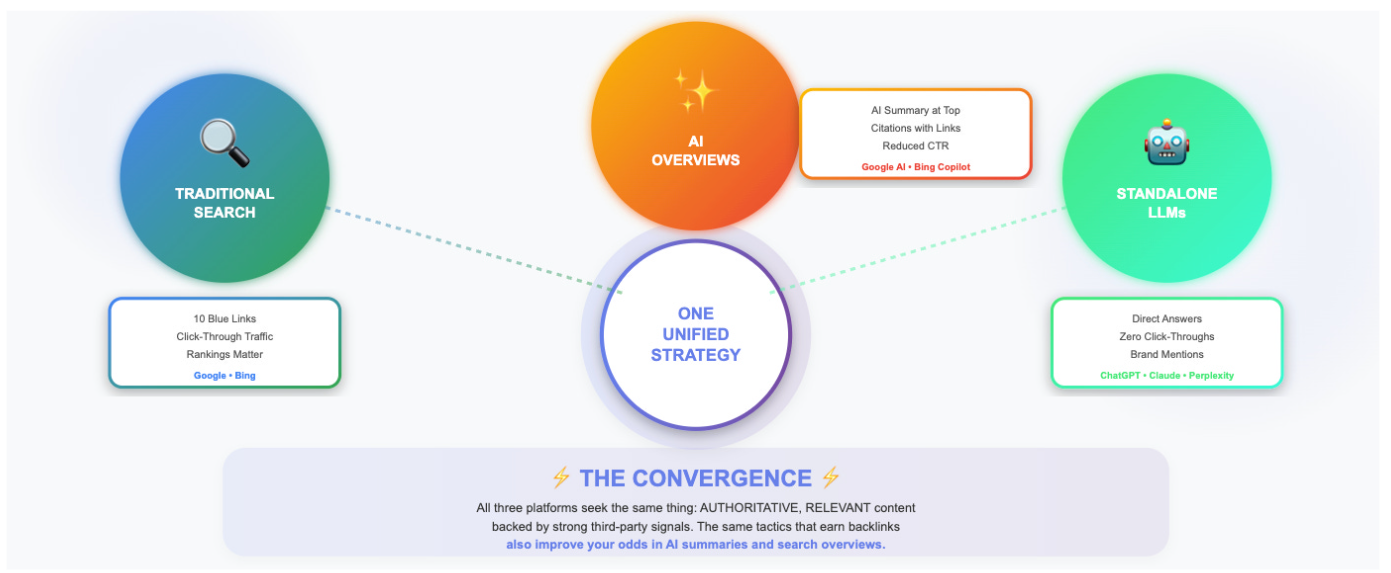

The built-in method doesn’t require three separate content material methods—the identical ideas that work for search engine marketing additionally optimize for reply engines and generative AI quotation, supplying you with most visibility throughout all search modalities.
Whether or not you’re utilizing Google or ChatGPT, each platforms attempt to floor probably the most authoritative, related content material on a given topic. They do that by figuring out which entities (manufacturers or sources) have offered strong material experience backed by robust third-party authority indicators.
This convergence means the identical ways that earn protection, backlinks, and social engagement additionally enhance your odds in AI summaries and search overviews. Authority (citations and mentions), originality (first-party analysis and insights), and belief (consistency throughout platforms and personas) are actually important inputs for big language fashions.
The Technical Necessities: What AI Brokers Demand from E-commerce Infrastructure
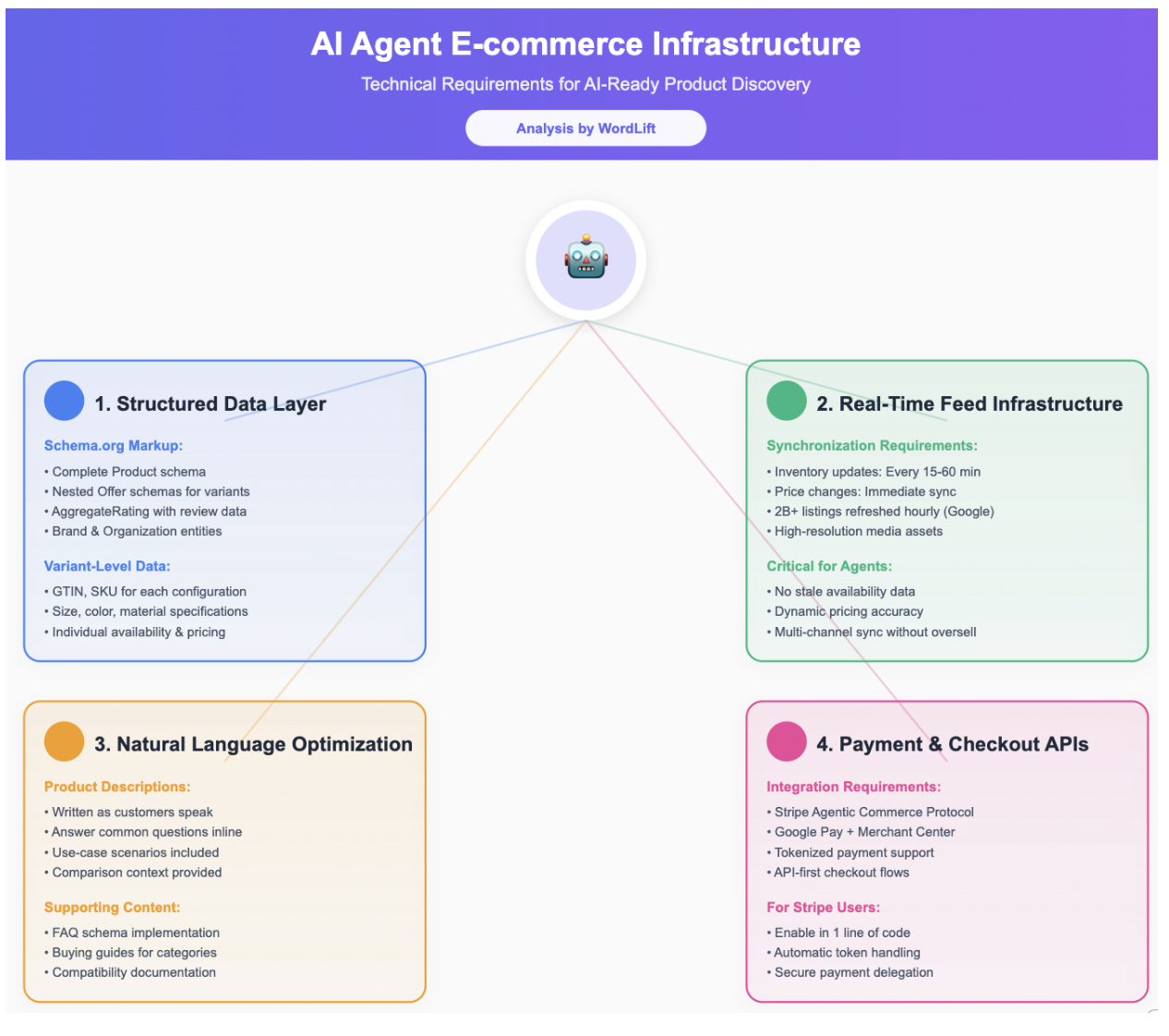

Structured Knowledge as Survival Mechanism
Within the AI-agent period, in case your product can’t be parsed, it doesn’t exist. This isn’t hyperbole—it’s the elemental requirement for visibility in agent-mediated commerce.
Conventional search engine marketing allowed for ambiguity. A poorly structured product web page with weak metadata would possibly nonetheless rank if the content material was robust and backlinks had been authoritative. AI brokers function in another way. They parse structured representations of merchandise to make speedy comparisons throughout hundreds of choices. Lacking attributes, incomplete schemas, or inconsistent information formatting don’t simply damage rankings—they end in full exclusion from consideration.
The technical bar has risen dramatically, and the necessities are particular:
Schema.org Markup Necessities:
Full Product schema with value, availability, specs, photos, and hierarchical categorization.
Nested Supply schemas for all variants (measurement, shade, materials) with particular person SKUs, pricing, and availability.
AggregateRating information with assessment counts, common scores, and ideally distribution of scores.
Model and Group entities with correct validation, relationships, and authority indicators.
Based on steering for e-commerce sellers: “Ecommerce sellers ought to guarantee their product listings and checkout flows are appropriate with agentic interactions by submitting structured product information that clearly defines variants corresponding to GTIN, measurement, shade, and materials. Google’s AI wants this element to permit customers to trace and purchase particular configurations—not simply the dad or mum product.”
The variant-level specificity is important. When a person asks an AI agent to “monitor this product in measurement medium, blue, and notify me if it drops under $50,” the agent wants machine-readable information that identifies that precise configuration. Father or mother-level product information with out variant specs makes this inconceivable.
Feed Infrastructure Necessities:
Actual-time stock synchronization: Google’s Buying Graph refreshes greater than 2 billion listings each hour. Outdated availability causes friction in checkout or prevents surfacing altogether.
Variant-level attribute specification: Each configuration wants full information—not simply the dad or mum product.
Pricing accuracy at scale: Dynamic pricing should replace in feeds instantly, as brokers evaluate costs in real-time throughout retailers.
Wealthy media belongings: Excessive-resolution photos, a number of angles, life-style images, and ideally 360-degree views.
The synchronization requirement represents a big operational problem. Many e-commerce techniques batch-update product feeds each few hours and even day by day. In agent-mediated commerce, this latency means brokers could present out-of-stock merchandise or incorrect costs, resulting in buyer frustration and misplaced gross sales when checkout fails.
Cost and Checkout Integration:
Google Pay and Google Service provider Middle integration: Agentic checkout flows depend on these techniques so as to add gadgets to cart and full purchases securely.
Stripe integration for Agentic Commerce Protocol: For retailers already on Stripe, enabling agentic funds requires as little as one line of code.
Tokenized cost help: Utilizing Stripe’s Shared Cost Token API or adopting the Delegated Funds Spec for retailers utilizing different processors.
API-first checkout flows: Brokers should be capable to programmatically navigate checkout with out human form-filling.
The protocol structure diagram from OpenAI reveals the stream: Person confirms buy → ChatGPT gathers safe cost token → Service provider’s backend receives order through ACP → Service provider calculates tax and remaining value → Service provider accepts/declines through their cost processor → Completion affirmation flows again via the chain.
This complete stream should work programmatically, with out guide intervention. E-commerce platforms constructed round human form-filling and multi-page checkout sequences want architectural updates to help agent-mediated transactions.
The Protocol Adoption Determination: First-Mover Benefit vs. Platform Lock-In
Within the AI-agent period, in case your product can’t be parsed, it doesn’t exist. This isn’t hyperbole—it’s the elemental requirement for visibility in agent-mediated commerce.
Conventional search engine marketing allowed for ambiguity. A poorly structured product web page with weak metadata would possibly nonetheless rank if the content material was robust and backlinks had been authoritative. AI brokers function in another way. They parse structured representations of merchandise to make speedy comparisons throughout hundreds of choices. Lacking attributes, incomplete schemas, or inconsistent information formatting don’t simply damage rankings—they end in full exclusion from consideration.
The technical bar has risen dramatically, and the necessities are particular:
Schema.org Markup Necessities:
Full Product schema with value, availability, specs, photos, and hierarchical categorization.
Nested Supply schemas for all variants (measurement, shade, materials) with particular person SKUs, pricing, and availability.
AggregateRating information with assessment counts, common scores, and ideally distribution of scores.
Model and Group entities with correct validation, relationships, and authority indicators.
Based on steering for e-commerce sellers: “Ecommerce sellers ought to guarantee their product listings and checkout flows are appropriate with agentic interactions by submitting structured product information that clearly defines variants corresponding to GTIN, measurement, shade, and materials. Google’s AI wants this element to permit customers to trace and purchase particular configurations—not simply the dad or mum product.”
The variant-level specificity is important. When a person asks an AI agent to “monitor this product in measurement medium, blue, and notify me if it drops under $50,” the agent wants machine-readable information that identifies that precise configuration. Father or mother-level product information with out variant specs makes this inconceivable.
Feed Infrastructure Necessities:
Actual-time stock synchronization: Google’s Buying Graph refreshes greater than 2 billion listings each hour. Outdated availability causes friction in checkout or prevents surfacing altogether.
Variant-level attribute specification: Each configuration wants full information—not simply the dad or mum product.
Pricing accuracy at scale: Dynamic pricing should replace in feeds instantly, as brokers evaluate costs in real-time throughout retailers.
Wealthy media belongings: Excessive-resolution photos, a number of angles, life-style images, and ideally 360-degree views.
The synchronization requirement represents a big operational problem. Many e-commerce techniques batch-update product feeds each few hours and even day by day. In agent-mediated commerce, this latency means brokers could present out-of-stock merchandise or incorrect costs, resulting in buyer frustration and misplaced gross sales when checkout fails.
Cost and Checkout Integration:
Google Pay and Google Service provider Middle integration: Agentic checkout flows depend on these techniques so as to add gadgets to cart and full purchases securely.
Stripe integration for Agentic Commerce Protocol: For retailers already on Stripe, enabling agentic funds requires as little as one line of code.
Tokenized cost help: Utilizing Stripe’s Shared Cost Token API or adopting the Delegated Funds Spec for retailers utilizing different processors.
API-first checkout flows: Brokers should be capable to programmatically navigate checkout with out human form-filling.
The protocol structure diagram from OpenAI reveals the stream: Person confirms buy → ChatGPT gathers safe cost token → Service provider’s backend receives order through ACP → Service provider calculates tax and remaining value → Service provider accepts/declines through their cost processor → Completion affirmation flows again via the chain.
This complete stream should work programmatically, with out guide intervention. E-commerce platforms constructed round human form-filling and multi-page checkout sequences want architectural updates to help agent-mediated transactions.
The Backside Line: The Largest E-commerce Alternative Since Cell
The convergence of ChatGPT’s Immediate Checkout, Google’s AI Mode procuring options, and the broader shift towards agentic commerce represents probably the most important progress alternative in e-commerce because the smartphone revolution—and the difference window is slim.
The proof is compelling:
The economics are distinctive: AI-referred site visitors converts at 11.4%, practically double conventional direct site visitors, with year-over-year progress of 45% and accelerating adoption. This interprets on to 18-30% reductions in buyer acquisition prices in comparison with paid search and social promoting.
The size is very large: 700 million weekly ChatGPT customers plus billions utilizing Google AI Mode represents distribution entry that might value tons of of hundreds of thousands to construct organically.
The timing is perfect: We’re within the land-grab part the place early adopters set up benefits that compound over time—algorithm preferences, model recognition, operational experience, and information insights that later entrants can’t simply replicate.
The technical necessities create moats: Complete structured information, real-time feeds, and API-first structure sound like prices however perform as aggressive benefits. Excellence in these areas instantly differentiates retailers from the 90%+ who haven’t invested in AI-ready infrastructure.
The platform incentives align: Transaction payment income gives platforms with sustainable enterprise fashions, creating long-term dedication. Not like advert platforms that may reduce off site visitors in a single day, AI commerce protocols are open-source and multi-platform, decreasing lock-in threat.
Sure, there are reliable challenges to handle:
Platform dependencies that require strategic balancing.
Margin stress from transaction charges.
Decreased model visibility when purchases occur in-agent.
The necessity to keep excellence throughout each AI and conventional channels.
However these challenges are manageable with correct technique, whereas lacking the chance isn’t.
For e-commerce companies—from particular person retailers to enterprise retailers—the difference window is slim. The businesses that can thrive in agent-mediated commerce are people who acknowledge this isn’t about defensive positioning. It’s about offensive alternative seize.
The winners will likely be retailers who:
Transfer decisively to ascertain early presence in AI commerce earlier than competitors matures.
Spend money on information infrastructure that creates sustainable aggressive benefits.
Construct hybrid channel methods that leverage AI brokers for acquisition whereas sustaining owned-property relationships.
Concentrate on high quality indicators that AI brokers reward—critiques, experience, uniqueness, belief.
Take a look at and be taught quickly to know this new buyer conduct earlier than others.
The technical necessities are clear: structured information, real-time feeds, API-first structure, and protocol integration. The strategic decisions require nuance: which merchandise to supply via brokers, stability channel dependencies, the place to spend money on brand-building that transcends platforms.
However the elementary choice is easy: take part early and seize benefit, or delay and battle for scraps after the land seize ends.
The e-commerce revolution took 20 years to reshape retail. The cell commerce revolution took lower than a decade. The AI commerce revolution could reshape the trade in 2-3 years.
The info is obvious: 11.4% conversion charges, 45% year-over-year progress, 700 million weekly customers. This isn’t an experiment. It’s not a distinct segment channel. It’s quickly turning into the first method customers uncover and buy merchandise on-line.
The query isn’t whether or not what you are promoting will finally take part in AI commerce—it’s whether or not you’ll be positioned to seize the early-mover benefits that outline market leaders, or taking part in catch-up whereas rivals who transfer sooner construct insurmountable moats.
The transactional internet is being rewritten. The one query is whether or not what you are promoting will assist write the brand new structure or be pressured to function inside techniques constructed by others.
The chance window is open. It received’t keep open lengthy.



